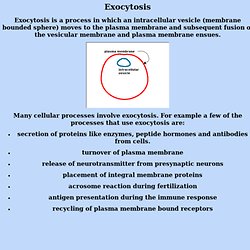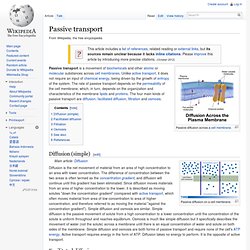

Untitled Document. Exocytosis is a process in which an intracellular vesicle (membrane bounded sphere) moves to the plasma membrane and subsequent fusion of the vesicular membrane and plasma membrane ensues.

Many cellular processes involve exocytosis. For example a few of the processes that use exocytosis are: secretion of proteins like enzymes, peptide hormones and antibodies from cells. Turnover of plasma membrane release of neurotransmitter from presynaptic neurons placement of integral membrane proteins acrosome reaction during fertilization antigen presentation during the immune response recycling of plasma membrane bound receptors. Diffusionrevision. Simple diffusion. The term simple diffusion refers to a process whereby a substance passes through a membrane without the aid of an intermediary such as a integral membrane protein.

The force that drives the substance from one side of the membrane to the other is the force of diffusion. In order for substances to pass through a cell membrane by simple diffusion it must penetrate the hydrophobic core of the phospholipid bilayer. The types of molecules that can do this are themselves substantially hydrophobic in nature such as carbon dioxide, oxygen or ethanol. In the figure below the green triangle indicates a concentration gradient of carbon dioxide. The blue arrow indicates the direction of net flow of carbon dioxide.
Passive Transport vs. Passive Transport Versus Active Transport Passive transport involves carriers, channels, or direct diffusion through a membrane.

This type of transport always operates from regions of greater concentration to regions of lesser concentration. No external source of energy is required. Examples of passive transport include ·Simple diffusion ·Channel diffusion ·Facilitated diffusion There are two types of active transport: ·Primary active transport ·Secondary active transport. In active transport it is possible to go against the concentration gradient. Primary Active Transport directly uses ATP. Secondary active transport does not directly use ATP. An example of the body needing to move against the concentration gradient can be found in looking at glucose in the intestine.
The body has to move glucose against the concentration gradient. There are three types of transport proteins: channels, carriers, and pumps. Passive transport. Passive transport is a movement of biochemicals and other atomic or molecular substances across cell membranes.

Unlike active transport, it does not require an input of chemical energy, being driven by the growth of entropy of the system. The rate of passive transport depends on the permeability of the cell membrane, which, in turn, depends on the organization and characteristics of the membrane lipids and proteins. The four main kinds of passive transport are diffusion, facilitated diffusion, filtration and osmosis. Diffusion (simple)[edit] Passive diffusion on a cell membrane. Diffusion is the net movement of material from an area of high concentration to an area with lower concentration. Facilitated diffusion[edit] Cell Function: Passive Transport. While active transport requires energy and work, passive transport does not. There are several different types of this easy movement of molecules. It could be as simple as molecules moving freely such as osmosis or diffusion . You may also see proteins in the cell membrane that act as channels to help the movement along. And of course there is an in-between transport process where very small molecules are able to cross a semi-permeable membrane .
Sometimes, proteins are used to help move molecules more quickly. Sometimes cells are in an area where there is a large concentration difference. Another big example of passive transport is osmosis. For a cell to survive, ion concentrations need to be the same on both sides of the cell membrane.